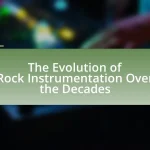The article focuses on the evolution of music production techniques in pop and rock, highlighting key milestones from the introduction of multitrack recording in the 1950s to the digital revolution of the 1980s and beyond. It examines how early recording technologies, such as magnetic tape and direct-to-disc methods, laid the groundwork for modern production practices. The piece also discusses the impact of synthesizers, digital audio workstations, and the rise of home studios on the music landscape, as well as current trends influenced by streaming platforms and artificial intelligence. Additionally, it outlines best practices for producers and common pitfalls to avoid in contemporary music production.

What are the key milestones in the evolution of music production techniques in pop and rock?
Key milestones in the evolution of music production techniques in pop and rock include the introduction of multitrack recording in the 1950s, which allowed for separate recording of instruments and vocals, enhancing creative possibilities. The 1960s saw the use of tape manipulation and effects like reverb and echo, exemplified by The Beatles’ innovative studio work on albums such as “Sgt. Pepper’s Lonely Hearts Club Band.” The 1970s introduced synthesizers and drum machines, revolutionizing sound with artists like Kraftwerk and the emergence of disco. The 1980s marked the digital revolution with the advent of digital audio workstations (DAWs) and sampling technology, enabling greater accessibility and experimentation, as seen in the works of Prince and Madonna. The 1990s and 2000s further advanced production techniques with the rise of home studios and software-based production, democratizing music creation and leading to diverse genres and styles. Each of these milestones significantly shaped the sound and production methods in pop and rock music, reflecting technological advancements and artistic innovation.
How did early recording technologies influence music production?
Early recording technologies significantly influenced music production by enabling the capture and reproduction of sound, which transformed how music was created and distributed. The introduction of technologies such as the phonograph in the late 19th century allowed for the first time the ability to record live performances, leading to the preservation of music and the ability to reach wider audiences. This innovation facilitated the rise of the music industry, as artists could now produce records that were commercially viable. Additionally, advancements like multi-track recording in the 1950s allowed for greater creativity and complexity in music production, enabling artists to layer sounds and create more polished recordings. These technological developments laid the groundwork for modern music production techniques, shaping the way music is produced and consumed today.
What were the first recording methods used in pop and rock music?
The first recording methods used in pop and rock music were primarily magnetic tape recording and direct-to-disc recording. Magnetic tape recording, developed in the late 1940s, allowed for multi-track recording, enabling artists to layer sounds and edit recordings more effectively. Direct-to-disc recording, used in the early 1950s, involved cutting the audio directly onto a disc, which limited the ability to edit but captured sound with high fidelity. These methods laid the foundation for modern recording techniques, as evidenced by their widespread adoption in the production of iconic albums during the 1950s and 1960s, such as Elvis Presley’s early works and The Beatles’ innovative studio experiments.
How did the introduction of magnetic tape change music production?
The introduction of magnetic tape revolutionized music production by enabling multi-track recording, which allowed for greater flexibility and creativity in the studio. Prior to magnetic tape, recording was primarily done on disc or wire, limiting artists to recording in a single take with minimal editing options. Magnetic tape facilitated the layering of different sound sources, allowing musicians to record multiple tracks separately and mix them together, which led to more complex and polished productions. This technology became widely adopted in the 1950s and 1960s, significantly influencing genres such as rock and pop, as artists could experiment with sound effects, overdubbing, and editing techniques that were previously impossible. The ability to manipulate recordings with precision contributed to the emergence of iconic albums and innovative soundscapes, marking a pivotal shift in the music industry.
What role did the advent of digital technology play in music production?
The advent of digital technology revolutionized music production by enabling greater accessibility, efficiency, and creativity in the recording process. Digital audio workstations (DAWs) allowed producers to manipulate sound with precision, facilitating complex arrangements and edits that were previously labor-intensive with analog equipment. For instance, the introduction of software like Pro Tools in the early 1990s transformed the industry by allowing for non-destructive editing and multi-track recording, which significantly streamlined workflows. Additionally, digital technology democratized music production, making it possible for independent artists to create high-quality recordings at home, as evidenced by the rise of home studios and the proliferation of affordable recording software. This shift not only expanded the diversity of music being produced but also altered the traditional roles within the music industry, as artists gained more control over their creative processes.
How did the transition from analog to digital impact sound quality?
The transition from analog to digital significantly improved sound quality by reducing noise and distortion while enhancing clarity and dynamic range. Digital audio allows for precise sampling and quantization, capturing sound waves more accurately than analog methods, which are susceptible to degradation over time and through repeated playback. For instance, digital formats like CDs offer a dynamic range of up to 96 dB, compared to the typical 60 dB of vinyl records, allowing for a more detailed and nuanced listening experience. Additionally, digital technology enables advanced editing and processing techniques, further refining sound quality in music production.
What are the key digital tools that revolutionized music production?
The key digital tools that revolutionized music production include Digital Audio Workstations (DAWs), MIDI controllers, and audio plugins. DAWs, such as Pro Tools and Ableton Live, allow for multi-track recording, editing, and mixing, fundamentally changing how music is created and produced. MIDI controllers enable musicians to input and manipulate musical notes digitally, enhancing creativity and efficiency in composition. Audio plugins, including virtual instruments and effects, provide a vast array of sounds and processing capabilities, allowing for high-quality production without the need for expensive hardware. These tools have collectively transformed the music production landscape, making it more accessible and versatile for artists across genres.

How have production techniques evolved in response to changing musical trends?
Production techniques have evolved significantly in response to changing musical trends by incorporating advanced technology and innovative methods. For instance, the transition from analog to digital recording in the late 20th century allowed for greater precision and flexibility, enabling producers to experiment with sound layering and effects. The rise of genres like hip-hop and electronic music in the 1980s and 1990s led to the widespread use of sampling and synthesizers, fundamentally altering the production landscape. Additionally, the advent of software like Pro Tools and Ableton Live has democratized music production, allowing independent artists to produce high-quality recordings from home studios. This evolution reflects the industry’s adaptation to new artistic expressions and consumer preferences, demonstrating a continuous interplay between technology and musical innovation.
What influence did the rise of synthesizers have on pop and rock music?
The rise of synthesizers significantly transformed pop and rock music by introducing new sounds and production techniques. Synthesizers allowed artists to create complex textures and innovative melodies that were previously unattainable with traditional instruments. For example, the use of synthesizers in the 1980s led to the emergence of genres like synth-pop, with bands such as Depeche Mode and Duran Duran achieving mainstream success through their distinctive electronic sound. Additionally, synthesizers enabled greater experimentation in music production, as seen in albums like “The Dark Side of the Moon” by Pink Floyd, which incorporated synthesizers to enhance its sonic landscape. This shift not only expanded the creative possibilities for musicians but also influenced the overall direction of popular music, making electronic elements a staple in contemporary pop and rock.
How did synthesizers change the sound of pop music in the 1980s?
Synthesizers fundamentally transformed the sound of pop music in the 1980s by introducing electronic textures and innovative soundscapes. This shift allowed artists to create a wide range of sounds that were previously unattainable with traditional instruments, leading to the emergence of genres like synth-pop. Iconic tracks such as “Sweet Dreams (Are Made of This)” by Eurythmics and “Take On Me” by A-ha exemplify this change, showcasing catchy melodies paired with synthesized instrumentation. The widespread use of synthesizers in production, as seen in albums like “Thriller” by Michael Jackson, which featured the synthesizer prominently, solidified their role in defining the decade’s musical identity.
What are the notable examples of synthesizer use in rock music?
Notable examples of synthesizer use in rock music include the iconic tracks “Jump” by Van Halen, which features a prominent synthesizer riff, and “Baba O’Riley” by The Who, known for its distinctive synthesizer intro. Additionally, Pink Floyd’s “On the Run” showcases innovative synthesizer techniques, while Genesis’s “The Musical Box” integrates synthesizers to enhance its progressive rock sound. These examples illustrate the significant role synthesizers have played in shaping the sound and texture of rock music, particularly during the late 1970s and 1980s, when their use became more prevalent in the genre.
How have production techniques adapted to the rise of home studios?
Production techniques have adapted to the rise of home studios by emphasizing digital technology and accessibility. The proliferation of affordable recording software and hardware has enabled musicians to produce high-quality music from their homes, leading to a shift from traditional studio environments to more flexible, DIY approaches. For instance, the use of digital audio workstations (DAWs) like Ableton Live and Pro Tools has become standard, allowing for intricate editing and mixing capabilities that were once only available in professional studios. Additionally, the availability of virtual instruments and plugins has expanded creative possibilities, enabling artists to experiment with sounds without the need for expensive equipment. This democratization of music production has resulted in a diverse range of styles and innovations, as independent artists can now produce and distribute their work without the constraints of traditional record labels.
What are the advantages of home studio production for artists?
Home studio production offers artists significant advantages, including cost-effectiveness, creative control, and flexibility. By eliminating the need for expensive studio rentals, artists can save money and allocate resources to other aspects of their projects. Creative control is enhanced as artists can experiment with sounds and arrangements without the pressure of time constraints typically found in commercial studios. Additionally, the flexibility of working from home allows artists to record at their convenience, fostering a more relaxed and productive environment. These factors collectively contribute to a more personalized and innovative music production process.
How has software like DAWs transformed the music production landscape?
Software like Digital Audio Workstations (DAWs) has fundamentally transformed the music production landscape by democratizing access to high-quality music creation tools. DAWs enable musicians and producers to record, edit, and mix music from their own homes, significantly reducing the need for expensive studio time and equipment. This shift has led to an explosion of independent artists and diverse musical styles, as evidenced by the rise of platforms like SoundCloud and Bandcamp, where countless tracks are produced using DAWs. According to a 2020 report by the International Federation of the Phonographic Industry, over 40% of music creators now use home studios equipped with DAWs, illustrating their widespread adoption and impact on the industry.

What are the current trends in music production techniques for pop and rock?
Current trends in music production techniques for pop and rock include the use of virtual instruments, advanced digital audio workstations (DAWs), and the integration of artificial intelligence in music creation. Virtual instruments allow producers to create high-quality sounds without the need for physical instruments, enhancing creativity and efficiency. Advanced DAWs, such as Ableton Live and Logic Pro, provide extensive features for editing, mixing, and mastering, enabling more complex arrangements and sound design. Additionally, artificial intelligence tools, like Amper Music and AIVA, assist in generating melodies and harmonies, streamlining the production process. These trends reflect a shift towards technology-driven methods that enhance both the creative and technical aspects of music production.
How is technology shaping the future of music production?
Technology is significantly shaping the future of music production by enabling innovative tools and techniques that enhance creativity and efficiency. Digital audio workstations (DAWs) allow producers to manipulate sound with unprecedented precision, while advancements in artificial intelligence facilitate automated mixing and mastering processes. For instance, AI-driven platforms like LANDR provide instant mastering services, which can save time and reduce costs for independent artists. Additionally, cloud-based collaboration tools enable musicians from different locations to work together seamlessly, fostering a more diverse and inclusive music-making environment. These technological advancements not only streamline production workflows but also democratize access to high-quality music production resources, ultimately transforming how music is created and consumed.
What role do artificial intelligence and machine learning play in music production?
Artificial intelligence and machine learning significantly enhance music production by automating processes, analyzing data, and generating creative content. These technologies enable producers to streamline tasks such as mixing, mastering, and sound design, allowing for more efficient workflows. For instance, AI algorithms can analyze thousands of songs to identify trends and suggest arrangements, while machine learning models can create original compositions or assist in sound synthesis. A notable example is the use of AI-driven tools like LANDR, which provides automated mastering services, demonstrating the practical application of these technologies in the industry.
How are streaming platforms influencing production choices in pop and rock?
Streaming platforms are significantly influencing production choices in pop and rock by prioritizing shorter song lengths and catchy hooks to enhance listener engagement and streaming metrics. This trend is evidenced by the rise of songs averaging around two to three minutes, as artists aim to capture attention quickly and encourage repeat plays, which are crucial for algorithm-driven playlists. For instance, data from Spotify indicates that tracks under three minutes are more likely to be added to popular playlists, directly impacting how producers and artists structure their music. Additionally, the accessibility of analytics provided by these platforms allows creators to tailor their sound and production techniques based on listener preferences, further shaping the evolution of music production in these genres.
What best practices should producers follow in modern music production?
Producers in modern music production should prioritize collaboration, utilize advanced technology, and maintain a clear vision throughout the creative process. Collaboration enhances creativity and innovation, as diverse perspectives can lead to unique soundscapes. Utilizing advanced technology, such as digital audio workstations (DAWs) and plugins, allows for greater flexibility and precision in sound design. Maintaining a clear vision ensures that the final product aligns with the intended artistic direction, which is crucial for achieving a cohesive sound. These practices are supported by industry trends showing that successful tracks often result from collaborative efforts and the effective use of technology, as evidenced by the rise of remote collaborations in recent years.
How can producers effectively blend traditional and modern techniques?
Producers can effectively blend traditional and modern techniques by integrating analog recording methods with digital technology. This approach allows for the warmth and character of analog sound to be preserved while utilizing the precision and flexibility of digital tools. For instance, using vintage microphones and tape machines alongside digital audio workstations enables producers to capture the nuances of live performances while benefiting from advanced editing capabilities. Historical examples include the use of analog synthesizers in modern pop music, which combines classic sounds with contemporary production techniques, demonstrating that this hybrid approach can enhance the overall quality and creativity of music.
What common pitfalls should be avoided in contemporary music production?
Common pitfalls to avoid in contemporary music production include over-compression, which can lead to a loss of dynamic range and listener fatigue. Over-compression is frequently seen in modern tracks, where producers aim for loudness but sacrifice audio quality. Another pitfall is neglecting the arrangement, as a poorly structured song can fail to engage listeners; effective arrangements are crucial for maintaining interest throughout a track. Additionally, relying too heavily on digital tools without understanding the fundamentals of music theory can result in uninspired compositions. This reliance on technology often leads to a lack of originality, as many producers may inadvertently create similar-sounding music. Lastly, ignoring the importance of mixing and mastering can diminish the overall impact of a track; a well-mixed and mastered song is essential for professional sound quality and listener enjoyment.




